 |
|
|
| (Information by Peter Kessler, with additional information by Keith Matthews, from Gesta Danorum, Saxo Grammaticus, from Viking-Rus Mercenaries in the Byzantine-Arab Wars of the 950s-960s: the Numismatic Evidence, Roman K Kovalev, from The Russian Primary Chronicle (Laurentian Text), Samuel Hazzard Cross & Olgerd P Sherbowitz-Wetzor (Eds and translators, Mediaeval Academy of America), from A History of Russian Architecture (Chapter 3: Vladimir and Suzdal Before the Mongol Invasion), William Craft Brumfield (Cambridge University Press, 1993), from Novgorodskaia Pervaia Letopis' Starshego i Mladshego Izvodov, A N Nasonov (Ed, ANSSR, 1950), from The Chronicle of Novgorod 1016-1471, Michell & Forbes (Eds, Translators, Offices of the Society, London, 1914), and from External Links: Worldstatesman, and Rurik of Novgorod and the Varangian DNA, and The Fragmentation & Decline of Kievan Rus, and Encyclopaedia.com, and The Map Archive.) |
|
|
| 1093 - 1125 |
Vladimir II Monomachus / Waldemar |
Son of Vsevolod. m Gytha, daughter of Harold II of England. |
| 1108 |
 Vladimir Monomachus, son of the late Grand Prince Vsevolod of Kyiv and rival of the current grand prince, Sviatopolk, 'founds' the new city of Vladimir within the territory of Rostov. Initially it serves as a defensive outpost for the principality. More recent historical analysis has concluded that Vladimir had instead been founded in 990 by Vladimir the Great of Kyiv, although even then an earlier settlement may have existed on the site (and see feature link). Vladimir Monomachus, son of the late Grand Prince Vsevolod of Kyiv and rival of the current grand prince, Sviatopolk, 'founds' the new city of Vladimir within the territory of Rostov. Initially it serves as a defensive outpost for the principality. More recent historical analysis has concluded that Vladimir had instead been founded in 990 by Vladimir the Great of Kyiv, although even then an earlier settlement may have existed on the site (and see feature link). 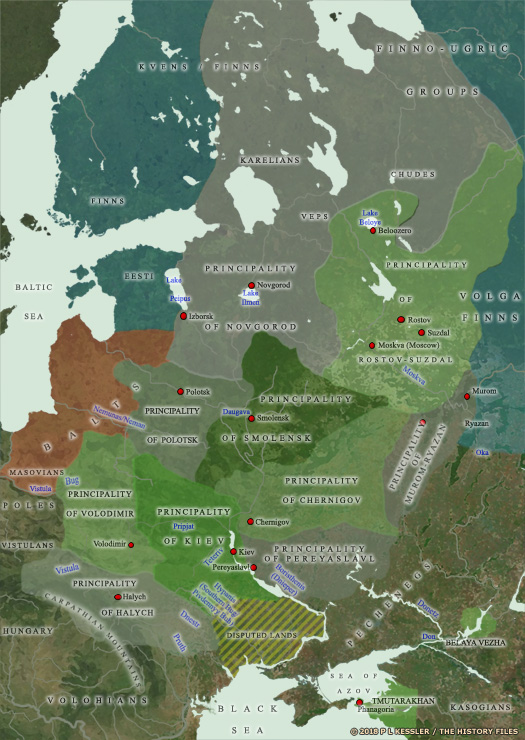 The death of Yaroslav 'the Wise' in 1054 saw the end of the descent of Rurikid power via agnatic seniority. His division of the succession weakened Kyiv by creating what soon turned out to be rival principalities for each of his sons (click or tap on map to view full sized) The death of Yaroslav 'the Wise' in 1054 saw the end of the descent of Rurikid power via agnatic seniority. His division of the succession weakened Kyiv by creating what soon turned out to be rival principalities for each of his sons (click or tap on map to view full sized) |
|
| 1113 |
The reunification of the principality of Kyiv is achieved upon the death of Sviatopolk, when his troublesome cousin, Vladimir Monomachus, is able to secure the throne and end years of on-off internecine conflict. Unfortunately for Kyiv, this new-found unity does not survive Vladimir. The rival Rus principalities are now too strong and too independent to be contained. |
|
| 1125 - 1132 |
Mstislav I 'the Great' |
Son. Ruled Kyiv & II of Novgorod. Nicknamed 'Harald'. |
| 1125 |
The two cities of Rostov and Suzdal are about the oldest settlements of their kind in the region, having been founded well before Vladimir (the latter subject to amendment but generally agreed to be in 990). The cities had already been important Rus trading posts in 862 when they had received their first mention in surviving historical records. Now the capital of the principality of Rostov is moved from Rostov to Suzdal, after which it becomes known as Rostov-Suzdal. |
|
| 1132 |
Mstislav is known as Harald in Norse sagas, possibly a nickname which alludes to his maternal grandfather, Harold II of England. After a lifetime spent fighting the Cumans, Estonians, Lithuanians, and Polotsk for ascendancy, his death effectively ends the unity of the Kievan Rus state. It is torn apart by various competing claims. Mstislav's son, Iziaslav, has been governing Polotsk before briefly being replaced by Sviatopolk and then by the Vitebsk Rurikids under Vasilko Sviatoslavich. His date of death - 1154 - strongly suggests that he controls Rostov-Suzdal along with his other princely holdings in Pereyaslav, Turov, and Kyiv (the latter as Izhaslav II). 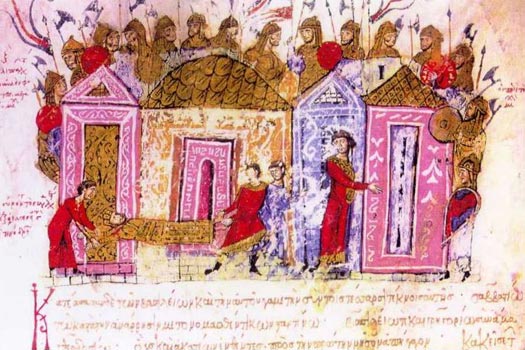 The Varangian Guards of the Byzantine court in the tenth century were recruited from eastern-travelling Vikings who came to Greece through the lands of the Rus The Varangian Guards of the Byzantine court in the tenth century were recruited from eastern-travelling Vikings who came to Greece through the lands of the Rus |
|
| 1132 - 1154 |
Izhaslav / Iziaslav |
Son. Was in Polotsk. In Kyiv (Iziaslav II), Pereyaslav, & Turov. |
| 1147 |
Yuri Dolgorukiy, a prince and soon-to-be ruling prince of Rostov-Suzdal, meets Sviatoslav Olgovich, prince of Belgorod Kievsky, in the otherwise unknown Moskva (Moscow). At this time Moskva is a minor town on the western border of Rostov-Suzdal, although Yuri Dolgorukiy is sometimes claimed as its founder - he certainly founds several fortresses and towns in the sparsely-populated north-eastern lands of the principality, and in 1156 he fortifies Moskva too. Sviatoslav is the exiled brother of Igor II of Kyiv and a supporter of Yuri's attempt to seize that mother city of the Rus. |
|
| 1151 |
Andrey Bogolyubski, the son of Yuri Dolgorukiy who will eventually become the first grand duke of Vladimir-Suzdal, secretly leaves his father's holdings at Vyshgorod, within Kyiv's territory to move his followers to Suzdal. |
|
| 1154 - 1157 |
Yuri (George) I Dolgorukiy |
Brother of Mstislav. In Kyiv (1149, 1150, & 1155). Poisoned? |
| 1154 |
Yuri and Izhaslav II have done little in recent years but drive each other out of Kyiv. Now Izhaslav has died and his uncle and co-ruler in Kyiv, Viacheslav, has followed him very soon afterwards. The Old Russian unified state is breaking up into numerous principalities which are constantly arguing and fighting amongst themselves. With Rotislav of Novgorod seizing Kyiv in this year, Yuri Dolgorukiy in Rostov-Suzdal is creating a dynasty which will strongly challenge Kyiv for superiority. Importantly, Rotislav's abandonment of Novgorod in favour of Kyiv allows Yuri's son, Mstislav, to be chosen by Novgorod's city's populace as their ruler. 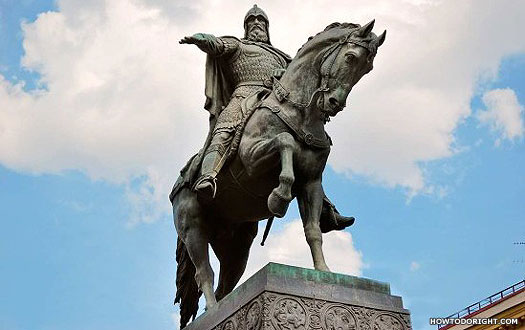 Legendary founder of Moscow, Yuri Dolgorukiy also created a Rus power centre in the north which would eventually form the heart of the Romanov empire Legendary founder of Moscow, Yuri Dolgorukiy also created a Rus power centre in the north which would eventually form the heart of the Romanov empire |
|
| 1157 |
With the death of Yuri Dolgorukiy, his son Andrey Bogolyubski has already ensured his powerbase in Rostov-Suzdal. Now he assumes command of the principality, primarily in opposition to Kyiv and renaming itVladimir-Suzdal to show the ascendancy of his new capital at Vladimir. |
|
|
|
|
| Principality of Vladimir-Suzdal (Rus) AD 1157 - 1328 The Rus presence in Eastern Slavic lands was initially confined to the major rivers and the trading settlements which formed along them. Led by Rurik, the Rus Vikings soon ruled the indigenous Slavs from their main base at Novgorod in the north and they quickly began exploring southwards to expand their trading routes. In the mid-ninth century the Eastern Polans settlement of Kyiv was captured and was made the mother of the cities of the Rus by Oleg, a kinsman of Rurik. Subsequently governed by the Rurik dynasty, the city became the heart of a grand principality and the guiding power in the Rus conquest of the east. It remained so until 1169 when it was sacked and the seat officially moved northwards to Vladimir. The gradual dilution of power between Kyiv and the increasingly influential lesser grand duchies had made such a loss of overall power inevitable. The principality of Rostov-Suzdal, located in the north-east of Rus lands, had quickly grown from its origins as a regional administrative centre under Novgorod's oversight to a major Rus power. It played a major role in destabilising Kyiv as the principle Rus city and benefited greatly from its diminishing status. Further Rus settlement took place in this period due to increased raids by Turkic tribes on Kyiv and the southern Rus lands. Numerous Rus migrated northwards to safer lands. The city of Vladimir was (probably) founded in 990 by Vladimir the Great of Kyiv, although a settlement may have existed here beforehand. It was from 1157 and the reign of St Andrey (I) Bogolyubski ('the Pious') that Vladimir became the principal city, replacing Rostov and Suzdal, and the principality became known as Vladimir-Suzdal. Another city - Moskva (Moscow) - had only recently been 'founded' within Vladimir-Suzdal, having been expanded from an initial fortress settlement and first being documented in 1147. It was located immediately south of the junction between the River Moskva and the mighty Volga, which provided direct access to the Gulf of Finland and the Baltic Sea. The Russian Primary Chronicle is a major source of information on the early states of the Rus. Much of the earliest material is legendary in nature, seemingly having been collated from various tales and folk memories which were then hung over a framework of dates which were taken from Byzantine sources. It was only from the accession of Yaroslav 'the Wise' of Kyiv in 1019 that its content rested largely on the personal reminiscences of contemporaries of the writers. Overall, the text is an homogeneous work which was compiled over a period of several years towards the close of the eleventh and the opening of the twelfth centuries, and it is highly important despite its unreliability in early entries. |
|
|
 |
|
|
| (Information by Peter Kessler, with additional information by Keith Matthews, from The Russian Primary Chronicle (Laurentian Text), Samuel Hazzard Cross & Olgerd P Sherbowitz-Wetzor (Eds and translators, Mediaeval Academy of America), from A History of Russian Architecture (Chapter 3: Vladimir and Suzdal Before the Mongol Invasion), William Craft Brumfield (Cambridge University Press, 1993), from Novgorodskaia Pervaia Letopis' Starshego i Mladshego Izvodov, A N Nasonov (Ed, ANSSR, 1950), from The Chronicle of Novgorod 1016-1471, Michell & Forbes (Eds, Translators, Offices of the Society, London, 1914), and from External Links: Worldstatesman, and Rurik of Novgorod and the Varangian DNA, and The Fragmentation & Decline of Kievan Rus, and Encyclopaedia.com, and The Map Archive.) |
|
|
| 1157 - 1174 |
St Andrey (I) Bogolyubski |
Son of Yuri I. Created Vladimir-Suzdal from Rostov-Suzdal. |
| 1169 |
Kyiv is sacked by the forces of Andrey Bogolyubskiy. The seat of the grand prince is moved to Vladimir while a reduced Kyiv is gifted with Gleb as its ruler, Andrey's younger brother. This ends Kyiv's pre-eminence as the principle city of the Rus, and trade with the Eastern Romans is also in decline, weakening its income. Apart from attempting to control Kyiv through his proxy, Andrey concentrates on building up Vladimir and improving its defences. 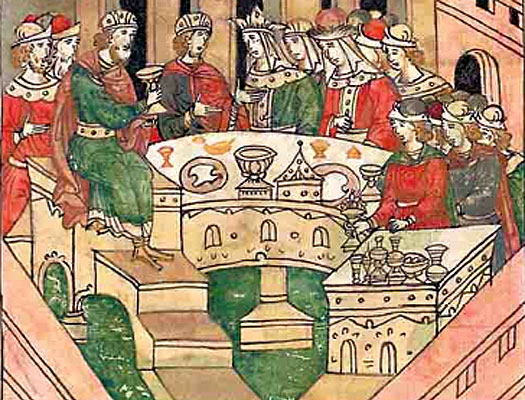 Gleb of Vladimir, known sometimes as Gleb of Kyiv, was in fact Gleb Yurievich, a son of Yuri Dolgorukiy, shown here on the occasion of his marriage to Iziaslavna of Chernigov Gleb of Vladimir, known sometimes as Gleb of Kyiv, was in fact Gleb Yurievich, a son of Yuri Dolgorukiy, shown here on the occasion of his marriage to Iziaslavna of Chernigov |
|
| 1173 - 1174 |
Two princes of Smolensk capture Kyiv and forcibly install one of the younger sons, Vsevolod III 'Big Nest', of the prolifically son-spawning Yuri Dolgorukiy as its new grand prince. His ransom is paid a year later and he is set free to return to Vladimir. Just the following year Andrey Bogolyubski is murdered in his bed by a gang of twenty unhappy boyars (nobles) at his suburban residence of Bogolyubovo. |
|
| 1174 |
Mikhail / Michael (I) |
Half-brother. In Kyiv (1171). Not fully in command. |
| 1174 - 1175 |
Yaropolk |
Grandson of Vladimir II of Kyiv (1113). In Novgorod (1178). |
| 1175 |
Having been forced to leave Vladimir due to the opposition of boyars who are unhappy at the city's sudden rise to pre-eminence at the expense of Rostov and Suzdal, Mikhail now returns. His seat has been taken by his nephew, Yaropalk, son of the late Rostislav Yuryevich, former prince of Novgorod (1139). Yaropalk is defeated and Mikhail regains control - only to die the following year. |
|
| 1175 - 1176 |
Mikhail / Michael (I) |
Restored after defeating Yaropalk. Died. |
| 1176 - 1212 |
Vsevolod 'Big Nest' |
Brother. m Maria Shvarnova (of Alania?). In Kyiv (1173). |
| 1176 |
The Eastern Romans are defeated by the Seljuqs of Rum at the Battle of Myriocephalon. The empire enters a period of uncertainty and gradual decline which also affects its allies. Kyiv is especially weakened by the continuing drop in trade goods, reducing its own wealth and importance even further than has already been the case. 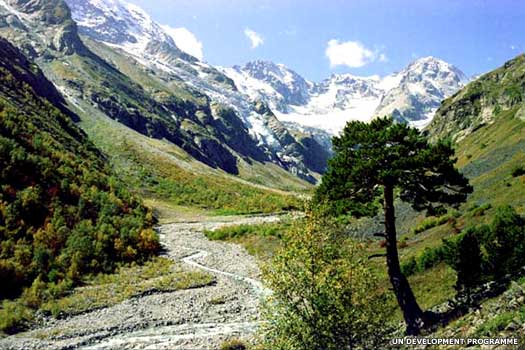 The countryside which traditionally formed the territory of Alania in the North Caucasus, now the Russian republic of North Ossetia-Alania, is mostly mountainous scrub The countryside which traditionally formed the territory of Alania in the North Caucasus, now the Russian republic of North Ossetia-Alania, is mostly mountainous scrub |
|
| 1212 - 1216 |
Yuri (George) II |
Son. Dispossessed in battle. |
| 1216 |
Yuri's elder brother, Konstantin, had been disinherited by their father when he had demanded both towns - Rostov and Vladimir - instead of Vladimir alone. Instead Yuri had been given Vadimir alongside his inheritance of Rostov and had also gained the seat of the principality. Konstantin now teams up with Mstislav 'the Bold' of Tmutarakan and Chernigov to seize the principality for himself after defeating Yuri and other brothers in battle on the River Lipitsa. |
|
| 1216 - 1218 |
Konstantin |
Brother. Novgorod (1205). Seized Vladimir by force. Died. |
| 1216 - 1218 |
During his short reign, Konstantin undertakes several campaigns against the Volga Bulgars. The fortress of Nizhny Novgorod is founded by him along the Volga as a defensive structure in case of reprisal attacks by the Bulgars, while he attempts to install a brother, Yaroslav (III), in Novgorod to secure control there (Yaroslav finally secures this seat in 1222, and succeeds Konstantin and Yuri in Vladimir-Suzdal in 1238). |
|
| 1218 - 1238 |
Yuri (George) II |
Allowed to return to Vladimir. Killed in battle. |
| 1221 or 1223 |
With the Mongol threat looming ever larger and Khwarazm having been defeated, a large Mongol force under Subedei continues north into territory around the Caspian Sea and into the lands of the Rus. An opposing Rus and Kipchak coalition is headed by Mstislav 'the Bold' of Tmutarakan, Chernigov, and Halych, Mstislav III 'the Old' of Kyiv, Daniel of Galicia (Halych), Mstislav II Svyatoslavich of Kozelsk (?), Novgorod-Seversk, and Chernigov, and Khan Koten of the Kipchaks. 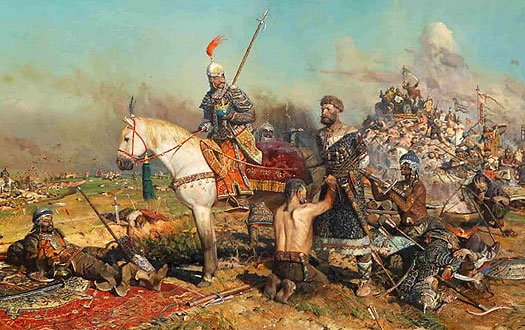 The Battle of the River Kalka in 1221 or 1223 (both dates are reported) was a valiant Rus effort to stem the westwards tide of Mongol advance, but due largely to the refusal of Mstislav 'the Bold' to wait for all of his allied forces to assemble before leaping into battle, it opened the gates to full invasion The Battle of the River Kalka in 1221 or 1223 (both dates are reported) was a valiant Rus effort to stem the westwards tide of Mongol advance, but due largely to the refusal of Mstislav 'the Bold' to wait for all of his allied forces to assemble before leaping into battle, it opened the gates to full invasion |
|
| At the Battle of the River Kalka (or Khalka) they face - but greatly outnumber - a large force led by the able Mongol generals, Subedei and Jebe. Mstislav 'the Bold' attacks before the rest of the Rus forces are ready and is defeated, resulting in defeat for the rest of them too. Ironically, Mstislav 'the Bold' escapes with his life, while Khan Koten makes a retreat into Hungary where he is murdered by the nobility there. Daniel is wounded, and Mstislav 'the Old' is murdered after being captured. Subedei extends his expedition farther to attack the Volga Bulgars before he returns to Mongolia in one of the greatest exploratory campaigns of the era. |
|
|
| 1237 - 1240 |
Batu Khan of the Golden Horde begins the invasion and conquest of the lands of the Rus, with Subedei agreeing to accompany him. They cross the Volga and, having been refused in their demand that Yuri II of Vladimir submits, they take the city of Riazan after a five-day catapult assault. Then they take Kolumna and Moscow, defeating and killing Yuri at the Battle of the River Sit, whilst leading the most powerful force in the northern half of the Rus lands (Yuri's death means he is succeeded by his brother Yaroslav, but it also seemingly signals the point at which the first prince of Moscow appears, this being Yaroslav's son, Mikhail). During the invasion, Kyiv is conquered by Danylo Romanovych of Halych-Volynia, creating another target for a Mongol attack. Cumans, Kipchaks, and other nomadic groups flee the Rus lands to seek refuge in Hungary. As Batu Khan sees these people as his subjects, news of their departure is not welcomed and plans are laid to pursue them.Novgorod survives the tidal wave of conquest because the Mongols are unable to find a route through the marshes. 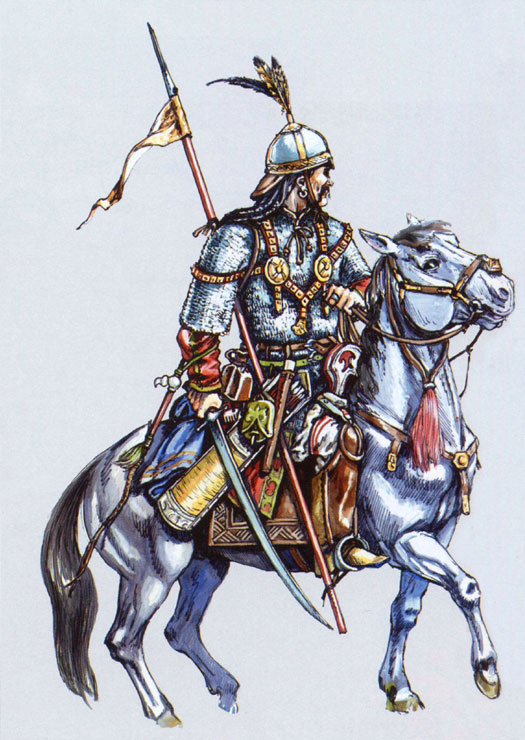 An illustration of a mounted Kipchack warrior, typical of the waves of westward migrants who swept in from the Kazak steppe during the eleventh and twelfth centuries, largely pushed that way by the sudden creation of the Mongol empire An illustration of a mounted Kipchack warrior, typical of the waves of westward migrants who swept in from the Kazak steppe during the eleventh and twelfth centuries, largely pushed that way by the sudden creation of the Mongol empire |
|
| Instead, they attack Kozelsk, which inflicts an unusual defeat on their vanguard before falling. Its entire population is slaughtered as an example. Kyiv also falls after a brave defence, even though Prince Michael of Kyiv flees beforehand. The city is largely destroyed. |
|
|
| 1238 - 1246 |
Yaroslav II |
Brother. In Novgorod (1215) & III of Kyiv (1236). Vassal. Killed. |
| 1241 - 1242 |
Vladimir-Suzdal is now tributary to the Golden Horde Mongols under Batu Khan and Subedei, and it is the great khan's mother who poisons Yaroslav in 1246. The two Mongol leaders turn their attention westwards in 1241. They invade Halych-Volynia in revenge for its capture of Kyiv, capturing the capital and destroying the cathedral. Then they invade Poland and Hungary. Both are conquered, with European defeats at Liegnitz and the River Sajo. [Austria](GermanyAustria.htm#Babenburg Margraves), Dalmatia, and Moravia also fall under Mongol domination, and the tide seems unstoppable. However, the death of Ogedei Khan causes the Mongols to withdraw, with Batu Khan intent on securing his conquests in the lands of the Rus. Also in 1242, on 5 April, Bishop Hermann and his Unguenois forces are defeated along with the Teutonic Knights by the prince of Novgorod, Alexander Yaroslavitz Nevsky, during the Battle of the Ice on Lake Peipsi. This halts the eastwards advance of the German crusaders and fixes Dorpat's border along Peipsi, where it remains to this day (with later Soviet era modifications). Nevsky will later be the prince of Vladimir (see below). 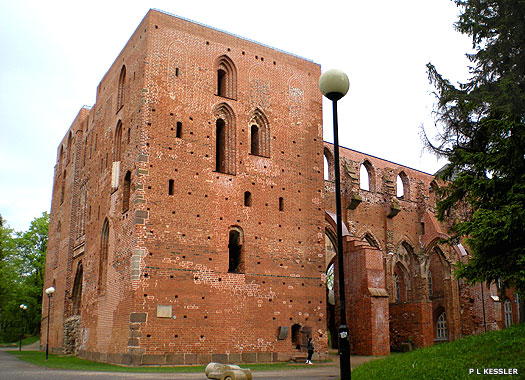 Tartu's modern ruins of the Dome Hill Church or cathedral date back to 1234, when a stone fortress replaced the original wooden one of the Unguenois (click or tap on image to view full sized) Tartu's modern ruins of the Dome Hill Church or cathedral date back to 1234, when a stone fortress replaced the original wooden one of the Unguenois (click or tap on image to view full sized) |
|
| Dorpat is captured and destroyed by the victorious Novgorod army but they fail to capture the Bishop's Fortress on the Dome Hill. Following the army's withdrawal a defensive wall is built around Dorpat's lower town, stretching for a total of about two kilometres. The destruction wrought by the Novgorod forces is recorded in Rus and German chronicles, which provide the first written evidence that, alongside the Bishop's Fortress, a settlement of German merchants and artisans has sprung up. |
|
|
| 1246 - 1248 |
Sviatoslav III |
Brother. In Novgorod (1200) Vassal. Removed by Mikhail. |
| 1248 |
Mikhail Khorobrit of Moscow |
Son of Yaroslav II. Prince of Moscow. Killed. |
| 1248 |
Sviatoslav has been removed from his seat as grand duke by his nephew, Mikhail Khorobrit, prince of Moscow. He appeals directly to his overlords, the Golden Horde, but Mikhail is killed in battle by the [ Lithuanians](EasternLithuania.htm#Kingdom of Lithuania) under the leadership of Tautvilas of the Samogitians and his co-commanders before any action can be taken. |
|
| 1248 - 1249 |
Sviatoslav III |
Restored. Died 1252. |
| 1249 - 1252 |
Andrey II |
Brother of Mikhail. In Novgorod. Vassal. Fled, then pardoned. |
| 1252 - 1253 |
Grand Prince Andrey allies himself with other princes of the western Rus in a move against the domination of the Golden Horde. Batu Khan sends out a punitive expedition which causes Andrey to flee first to Pskov and then to Sweden, and the population of Vladimir are punished for the crimes of their master. The Livonian Knights prevent the Mongols from advancing any farther north, while Alexander Nevsky is installed as the new grand prince of Vladimir. 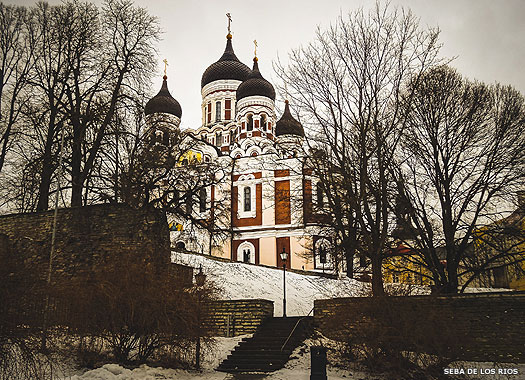 The Russian Orthodox Cathedral of Alexander Nevsky in Tallinn, Estonia, was built in 1894-1900, with the sainted Nevsky having been honoured for halting in 1242 the further eastwards advance of the German crusaders in the Baltics (click or tap on photo to read more on a separate page) The Russian Orthodox Cathedral of Alexander Nevsky in Tallinn, Estonia, was built in 1894-1900, with the sainted Nevsky having been honoured for halting in 1242 the further eastwards advance of the German crusaders in the Baltics (click or tap on photo to read more on a separate page) |
|
| 1253 - 1263 |
St Aleksandr Nevsky |
Brother. In Novgorod (1228) & Kyiv. Vassal. Died. |
| 1263 |
Aleksandr Nevsky's death means that his two year-old son, Daniel, inherits the smallest and least significant of his domains in the form of the newly-created duchy of Moscow. He is generally known as Daniel of Moscow, or Daniil Aleksandrovich. |
|
| 1264 - 1271 |
Yaroslav (III) of Tver |
Brother. In Tver (1247). In Kyiv (1263). Vassal. Died. |
| 1268 |
With both German crusaders and [ Lithuanians](EasternLithuania.htm#Grand Duchy of Lithuania) from the Baltics impinging on the territories of the various Rus principalities which are still vassals of the Golden Horde, Khan Mongke Temur sends troops to Novgorod to eject the Livonian Knights. |
|
| 1272 - 1276 |
Vasily of Kostroma / Basil |
Brother. In Novgorod (1273). Vassal of the Golden Horde. Died. |
| 1274 - 1275 |
Smolensk is the last of the independent principalities of the Rus, but it now falls to Mongke Temur of the Golden Horde. The following year he defends his Rus vassals by dispatching a Mongol-Rus force to ward off the [ Lithuanians](EasternLithuania.htm#Grand Duchy of Lithuania), an action which is requested by Duke Lev I of Halych-Volynia. |
|
| 1276 - 1281 |
Dmitry Alexandrovich / Demetrius |
Son of Aleksandr Nevsky. In Pereslavl & Novgorod. Vassal. |
| 1281 - 1283 |
Andrey III |
Brother. In Gorodets. 'Usurped' throne with permission. |
| 1283 - 1293 |
Dmitry Alexandrovich / Demetrius |
Restored. Vassal. Forced to abdicate. Died 1294 as a monk. |
| 1290 |
The last of the Old Prussian territories to fall as a result of continuous wars with the Poles of the eastern province of Masuria and Germans in the last quarter of the thirteenth century is Sūduva, the land of the Sudovians (Yotvingians). After the loss of nearly two-thirds of the Prussian territory in the south due to Russian and Polish expansion before the thirteenth century, and after a tremendous loss of life in the wars with the Germans, only some 170,000 Old Prussians are left. 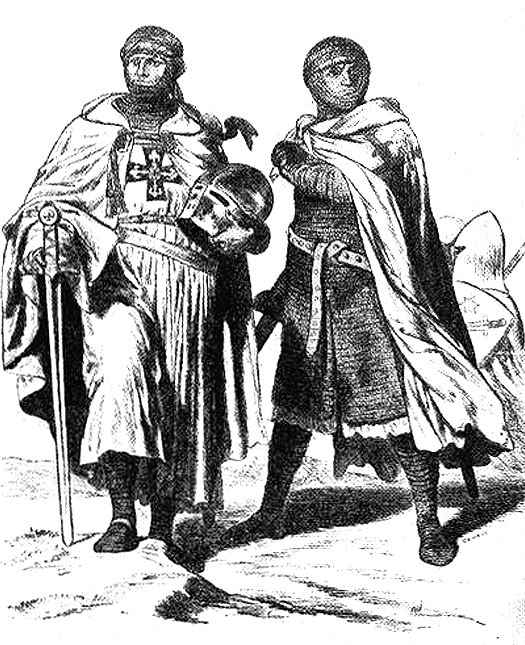 This image is taken from a somewhat later, slightly romanticised depiction of the Order of the Knights of the Sword, but their general uniform is of the same style as that of the better-known European crusaders of the Near East This image is taken from a somewhat later, slightly romanticised depiction of the Order of the Knights of the Sword, but their general uniform is of the same style as that of the better-known European crusaders of the Near East |
|
| 1291 |
Khan Tole Buga of the Golden Horde is not happy with the direct threat to his own power which is posed by Nogai Khan of the Nogai Horde. The loyalty of the Rus principalities is divided between the two of them and the unity of the Golden Horde is threatened. When Tole attempts to bring matters to a head, he is outmanoeuvred by his supposed subordinate and is arrested. Nogai has his replacement, Toqta, execute him. |
|
| 1293 |
Toqta Khan of the Golden Horde attempts to end the semi-independent rule of the Rus vassal princes by sending his brothers at the head of an army which devastates no less than fourteen towns. Toqta himself forces Grand Prince Demetrius of Pereslavl, grand prince of Vladimir, to abdicate, which is an important victory in itself as he is an ally of Nogai Khan of the Nogai Horde. The Rus record the campaign as the 'harsh-time of Batu returns'. |
|
| 1293 - 1304 |
Andrey III |
Restored. Vassal. |
| 1304 - 1317 |
St Michael / Mikhail of Tver |
Son of Yaroslav III. Executed by Golden Horde in 1318. |
| 1317 |
The princes of Moscow and its subsidiary states have been receiving the support of Ozbeg Khan, partially because the khan's sister, Konchaka, is married to Yuri Danilovich of Moscow. The princes of Moscow are opposed by the princes of Tver, their westward-leaning relatives, and it is the most senior of these, Mikhail of Tver, who defeats Yuri at a village named Bortenevo. Mikhail also manages to capture Konchaka, who subsequently dies in his keeping. Yuri announces to Ozbeg that Konchaka had been poisoned, so he and Mikhail are summoned to the Golden Horde's capital of Sarai for trial. Mikhail is found guilty and is beheaded the following year, while the yarlik (effectively a patent of office for the title of 'Grand Prince of Vladimir') is granted to Moscow. 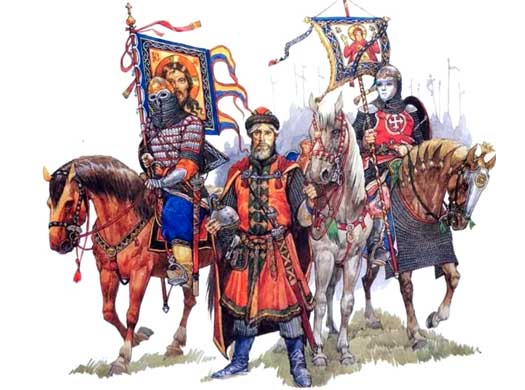 The Mongols maintained their dominance of the Rus with bloodletting where necessary, burning and destroying towns which stood against them and executing Prince Michael The Mongols maintained their dominance of the Rus with bloodletting where necessary, burning and destroying towns which stood against them and executing Prince Michael |
|
| 1318 - 1322 |
Yuri (III) Danilovich of Moscow |
Grandson of Aleksandr. In Moscow. Killed by Dimitry of Tver. |
| 1318 - 1322 |
The sons of Mikhail of Tver, Dimitry (or Dmitri) and Alexander Mikhailovich, fight a series of battles against Yuri Danilovich of Moscow. By intriguing with the royal court of the Golden Horde, Dmitry manages to gain the yarlik for Vladimir in 1322. |
|
| 1321 |
In or around this year (the dating is uncertain as the various chronicles which cover this event are only written down afterwards), [ Lithuania](EasternLithuania.htm#Grand Duchy of Lithuania) meets Kyiv in battle. Prince Stanislav Ivanovich is allied to the principalities of Pereyaslavl and Bryansk under Oleg and Roman respectively, but their joint forces are defeated at the Battle of the River Irpin. Kyiv now falls under Lithuanian influence, although the city itself successfully withstands a siege. |
|
| 1322 - 1326 |
Dimitry |
Son of St Mikhail of Tver. Vassal. Executed. |
| 1325 - 1326 |
The metropolitan of Kievan Rus moves his seat in 1325 from Vladimir to Moscow, making it clear that he regards Moscow as the principal city of the grand duchy of Vladimir. The city of Vladimir is reduced in importance by the move. Yuri Danilovich of Moscow is killed by Dmitry in the same year, before he can clear his name and regain the yarlik. Ozbeg of the Golden Horde arrests Dimity for the murder and executes him in 1326. 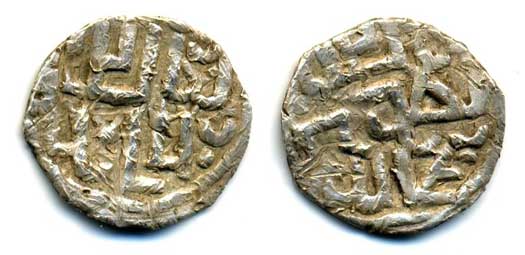 This Russian imitation is of a coin issued (possibly) during the short-lived khanate of Berdi Beg (1357-1359), the victim of an all-too-familiar assassination in the Blue Horde This Russian imitation is of a coin issued (possibly) during the short-lived khanate of Berdi Beg (1357-1359), the victim of an all-too-familiar assassination in the Blue Horde |
|
| 1326 - 1327 |
Alexander Mikhailovich of Tver |
Brother. Novgorod (1325). Vassal. Later in Pskov. Killed. |
| 1327 - 1328 |
Baskaki Shevkal, cousin to Ozbeg Khan, is killed in Tver along with his Tartars and rebellion is ignited against the Golden Horde's overlordship. Grand Prince Alexander Mikhailovich is forced to flee, first to Novgorod which refuses him, and then to Pskov. Not only does Pskov welcome him - it makes him the ruling prince. The Golden Horde sends an expedition which consists of fifty thousand Mongol-Tartars and Muscovites led by Ivan Danilovich, brother and successor of Yuri. The uprising in Tver is brutally suppressed, and Ozbeg appoints Ivan as grand duke of Vladimir in 1328. Ivan's seat, though, is in Moscow, which now means the end of Vladimir as a city which carries any meaningful authority. |
|
| 1328 - 1331 |
Alexander III |
Grandson of Andrey II. Vassal. Not grand duke. Died 1339. |
| 1330 |
[ Lithuania](EasternLithuania.htm#Grand Duchy of Lithuania) defeats the boyars of the Rus and occupies Kyiv and its surrounding territory. The loss of this vassal state by the Golden Horde removes not only it from their control, but also cuts off Wallachia whose ruler, Basarab I, effectively becomes independent, although this has increasingly been the case for several years. However, despite this setback, Ozbeg is still able to threaten the Bulgars, Byzantium, and the Lithuanians themselves. |
|
| 1332 - 1340 |
Ivan I of Moscow |
Grandson of St Aleksandr. Permanently in Moscow (1332). |
| 1340 |
Now in the official position of collecting taxes from all the Rus lands before passing them onto his overlords, the Golden Horde, Ivan Kalita, prince of Moscow and grand duke of Vladimir, greatly increases his own prestige and power ('kalita' means 'the moneybag'). 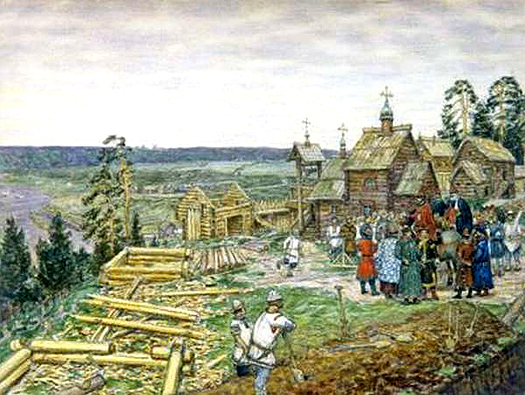 Early Moscow began life as a defensive outpost in heavily wooded terrain in the southern section of Vladimir-Suzdal, but its favourable location quickly saw it progress into the principality's leading city Early Moscow began life as a defensive outpost in heavily wooded terrain in the southern section of Vladimir-Suzdal, but its favourable location quickly saw it progress into the principality's leading city |
|
| Nobles and peasants alike flock to Moscow and the greater protection it offers from raids, while Ivan makes loans to the other principalities which weakens their positions and makes them increasingly liable to being absorbed under Moscow's control. Vladimir becomes insignificant, with all power now being held in Moscow. |
|
|
 |
|
|

 Vladimir Monomachus, son of the late Grand Prince Vsevolod of Kyiv and rival of the current grand prince, Sviatopolk, 'founds' the new city of Vladimir within the territory of Rostov. Initially it serves as a defensive outpost for the principality. More recent historical analysis has concluded that Vladimir had instead been founded in 990 by Vladimir the Great of Kyiv, although even then an earlier settlement may have existed on the site (and see feature link).
Vladimir Monomachus, son of the late Grand Prince Vsevolod of Kyiv and rival of the current grand prince, Sviatopolk, 'founds' the new city of Vladimir within the territory of Rostov. Initially it serves as a defensive outpost for the principality. More recent historical analysis has concluded that Vladimir had instead been founded in 990 by Vladimir the Great of Kyiv, although even then an earlier settlement may have existed on the site (and see feature link).  The death of Yaroslav 'the Wise' in 1054 saw the end of the descent of Rurikid power via agnatic seniority. His division of the succession weakened Kyiv by creating what soon turned out to be rival principalities for each of his sons (click or tap on map to view full sized)
The death of Yaroslav 'the Wise' in 1054 saw the end of the descent of Rurikid power via agnatic seniority. His division of the succession weakened Kyiv by creating what soon turned out to be rival principalities for each of his sons (click or tap on map to view full sized) The Varangian Guards of the Byzantine court in the tenth century were recruited from eastern-travelling Vikings who came to Greece through the lands of the Rus
The Varangian Guards of the Byzantine court in the tenth century were recruited from eastern-travelling Vikings who came to Greece through the lands of the Rus Legendary founder of Moscow, Yuri Dolgorukiy also created a Rus power centre in the north which would eventually form the heart of the Romanov empire
Legendary founder of Moscow, Yuri Dolgorukiy also created a Rus power centre in the north which would eventually form the heart of the Romanov empire
 Gleb of Vladimir, known sometimes as Gleb of Kyiv, was in fact Gleb Yurievich, a son of Yuri Dolgorukiy, shown here on the occasion of his marriage to Iziaslavna of Chernigov
Gleb of Vladimir, known sometimes as Gleb of Kyiv, was in fact Gleb Yurievich, a son of Yuri Dolgorukiy, shown here on the occasion of his marriage to Iziaslavna of Chernigov The countryside which traditionally formed the territory of Alania in the North Caucasus, now the Russian republic of North Ossetia-Alania, is mostly mountainous scrub
The countryside which traditionally formed the territory of Alania in the North Caucasus, now the Russian republic of North Ossetia-Alania, is mostly mountainous scrub The Battle of the River Kalka in 1221 or 1223 (both dates are reported) was a valiant Rus effort to stem the westwards tide of Mongol advance, but due largely to the refusal of Mstislav 'the Bold' to wait for all of his allied forces to assemble before leaping into battle, it opened the gates to full invasion
The Battle of the River Kalka in 1221 or 1223 (both dates are reported) was a valiant Rus effort to stem the westwards tide of Mongol advance, but due largely to the refusal of Mstislav 'the Bold' to wait for all of his allied forces to assemble before leaping into battle, it opened the gates to full invasion An illustration of a mounted Kipchack warrior, typical of the waves of westward migrants who swept in from the Kazak steppe during the eleventh and twelfth centuries, largely pushed that way by the sudden creation of the Mongol empire
An illustration of a mounted Kipchack warrior, typical of the waves of westward migrants who swept in from the Kazak steppe during the eleventh and twelfth centuries, largely pushed that way by the sudden creation of the Mongol empire Tartu's modern ruins of the Dome Hill Church or cathedral date back to 1234, when a stone fortress replaced the original wooden one of the Unguenois (click or tap on image to view full sized)
Tartu's modern ruins of the Dome Hill Church or cathedral date back to 1234, when a stone fortress replaced the original wooden one of the Unguenois (click or tap on image to view full sized) The Russian Orthodox Cathedral of Alexander Nevsky in Tallinn, Estonia, was built in 1894-1900, with the sainted Nevsky having been honoured for halting in 1242 the further eastwards advance of the German crusaders in the Baltics (click or tap on photo to read more on a separate page)
The Russian Orthodox Cathedral of Alexander Nevsky in Tallinn, Estonia, was built in 1894-1900, with the sainted Nevsky having been honoured for halting in 1242 the further eastwards advance of the German crusaders in the Baltics (click or tap on photo to read more on a separate page) This image is taken from a somewhat later, slightly romanticised depiction of the Order of the Knights of the Sword, but their general uniform is of the same style as that of the better-known European crusaders of the Near East
This image is taken from a somewhat later, slightly romanticised depiction of the Order of the Knights of the Sword, but their general uniform is of the same style as that of the better-known European crusaders of the Near East The Mongols maintained their dominance of the Rus with bloodletting where necessary, burning and destroying towns which stood against them and executing Prince Michael
The Mongols maintained their dominance of the Rus with bloodletting where necessary, burning and destroying towns which stood against them and executing Prince Michael This Russian imitation is of a coin issued (possibly) during the short-lived khanate of Berdi Beg (1357-1359), the victim of an all-too-familiar assassination in the Blue Horde
This Russian imitation is of a coin issued (possibly) during the short-lived khanate of Berdi Beg (1357-1359), the victim of an all-too-familiar assassination in the Blue Horde Early Moscow began life as a defensive outpost in heavily wooded terrain in the southern section of Vladimir-Suzdal, but its favourable location quickly saw it progress into the principality's leading city
Early Moscow began life as a defensive outpost in heavily wooded terrain in the southern section of Vladimir-Suzdal, but its favourable location quickly saw it progress into the principality's leading city